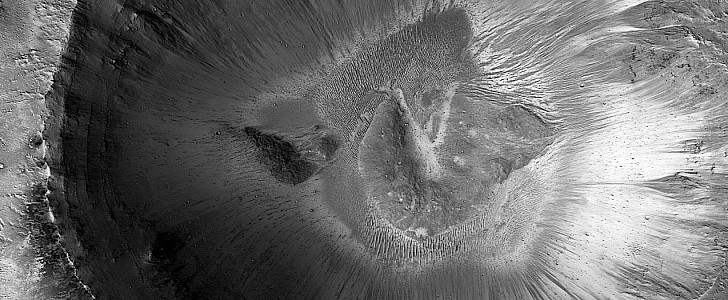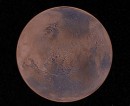One has to be incredibly grateful to Mars for lacking any features that might otherwise prevent us from seeing incredible images on its surface. With no vegetation, large bodies of water, or dense atmosphere, the planet is fully exposed to our eyes to admire and our brains to make whatever they want of it.
With an incredibly large number of photographs sent back from Mars by the Reconnaissance Orbiter, and something called pareidolia to guide our imagination every time our eyes fall on one, there’s virtually no limit to how Mars can appear to us.
Take the photo we have here. It shows the concave, rock-based nest of a fat, Martian hummingbird, whose shape (or fossil) can be distinguished at the bottom. It seems to have been frozen in time as it was getting ready to take flight, probably heading for that forest of distant trees we talked about not long ago.
Only it’s not. There are no hummingbirds on Mars, and that forest, well, that’s not a forest either.
That’s what pareidolia and a bit of imagination can do to any photo of Mars. That’s because we humans want to have this image of a romantic, or mysterious, or dangerous planet in our heads when talking about Mars, one that makes sense and is aligned with what we do understand.
But the reality is, for now, much duller. Here, you’re looking at a rather deep impact crater born sometime in Mars’ violent past in the Nanendi Valles region of the planet, located in a larger region called Xanthe Terra. There’s nothing particularly interesting about the place, other than the fact this image could help scientists learn more “about the fluvial and morphology characteristics of area.”
You know, because one day we humans might actually go there and see for ourselves if there are any hummingbirds.
Take the photo we have here. It shows the concave, rock-based nest of a fat, Martian hummingbird, whose shape (or fossil) can be distinguished at the bottom. It seems to have been frozen in time as it was getting ready to take flight, probably heading for that forest of distant trees we talked about not long ago.
Only it’s not. There are no hummingbirds on Mars, and that forest, well, that’s not a forest either.
That’s what pareidolia and a bit of imagination can do to any photo of Mars. That’s because we humans want to have this image of a romantic, or mysterious, or dangerous planet in our heads when talking about Mars, one that makes sense and is aligned with what we do understand.
But the reality is, for now, much duller. Here, you’re looking at a rather deep impact crater born sometime in Mars’ violent past in the Nanendi Valles region of the planet, located in a larger region called Xanthe Terra. There’s nothing particularly interesting about the place, other than the fact this image could help scientists learn more “about the fluvial and morphology characteristics of area.”
You know, because one day we humans might actually go there and see for ourselves if there are any hummingbirds.






